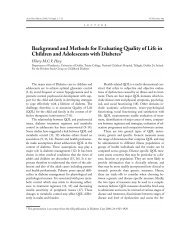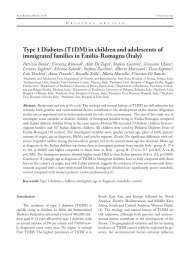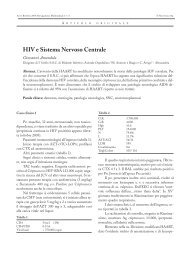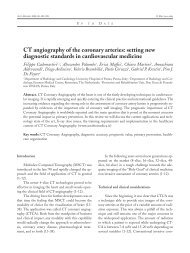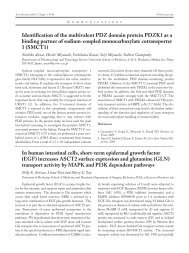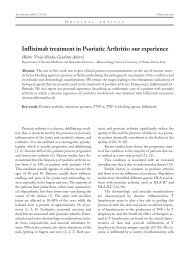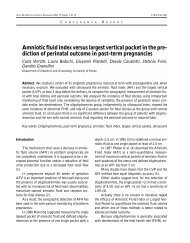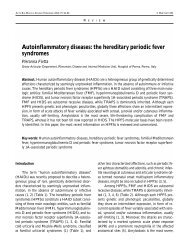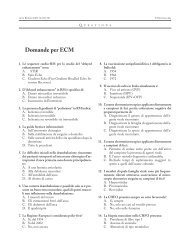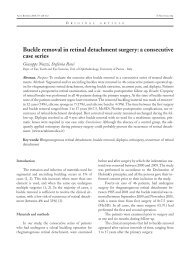One year experience at the Emergency Unit of the Children's ...
One year experience at the Emergency Unit of the Children's ...
One year experience at the Emergency Unit of the Children's ...
Create successful ePaper yourself
Turn your PDF publications into a flip-book with our unique Google optimized e-Paper software.
Paedi<strong>at</strong>ric emergency37ing-hours and prompt-availability <strong>of</strong> Family Paedi<strong>at</strong>riciansduring <strong>the</strong> weekend and holiday time should bemodified according to <strong>the</strong>ir p<strong>at</strong>ients demands. A fewFamily Paedi<strong>at</strong>ricians in Parma have already respondedpositively to <strong>the</strong>se demands by joining <strong>the</strong>ir consult<strong>at</strong>ionsin an associ<strong>at</strong>ed bureau in order to assure <strong>the</strong>ir p<strong>at</strong>ientsa continuous availability <strong>of</strong> <strong>at</strong> least one Paedi<strong>at</strong>ricianduring <strong>the</strong> day, weekend excluded. A similar solutionshould be encouraged everywhere. The discussionon <strong>the</strong> probability <strong>of</strong> involving Family Paedi<strong>at</strong>ricians in<strong>the</strong> functioning <strong>of</strong> a PEU as physician on call is stillunrisolved, although this solution has already been successfullyintroduced in some areas (4).All Authors agree th<strong>at</strong> special <strong>at</strong>tention must alsobe addressed to <strong>the</strong> users <strong>of</strong> a PEU in order to reduce<strong>the</strong>ir <strong>at</strong>tendance. In our <strong>experience</strong>, <strong>at</strong> least 80-90% <strong>of</strong> <strong>at</strong>tendances to <strong>the</strong> PEU were “subjectiveemergencies”. This means th<strong>at</strong> <strong>the</strong>y could be tre<strong>at</strong>ed <strong>at</strong>home by parents. To achieve this target in <strong>the</strong> future,a continuous health educ<strong>at</strong>ion and inform<strong>at</strong>ion programfor <strong>the</strong> general popul<strong>at</strong>ion and first-time parentshas to be planned (5). Mass-media could be useful toeduc<strong>at</strong>e and to accustom <strong>the</strong> general popul<strong>at</strong>ion to use<strong>the</strong> public health services more r<strong>at</strong>ionally, but for firsttimeparents an important effort has to be asked forfrom both hospital nursing and medical staff during<strong>the</strong> pre-n<strong>at</strong>al period, and Family Paedi<strong>at</strong>ricians afterbirth. Educ<strong>at</strong>ion programs need to be addressed particularlyto <strong>the</strong> parents <strong>of</strong> children aged below 5 <strong>year</strong>s<strong>of</strong> age, as <strong>the</strong>se resulted as being <strong>the</strong> most frequent p<strong>at</strong>ientsseeking consult<strong>at</strong>ion. Equally important is <strong>the</strong>educ<strong>at</strong>ion <strong>of</strong> parents on first aid training, recognition<strong>of</strong> signs and symptoms <strong>of</strong> a serious illness or a significantinjury, and indic<strong>at</strong>ions for seeking immedi<strong>at</strong>ecare. The provision <strong>of</strong> printed handouts and standardizeddiagnosis-driven discharge instructions, alongwith verbal communic<strong>at</strong>ion during “well child” or urgentcare visits are also helpful mechanisms for informingparents which emergency situ<strong>at</strong>ions may handled<strong>at</strong> home without <strong>at</strong>tending a PEU (6).Sixteen per cent <strong>of</strong> p<strong>at</strong>ients <strong>of</strong> our PEU were admittedfor a short clinical observ<strong>at</strong>ion. In 44% <strong>of</strong> <strong>the</strong>m<strong>the</strong> stay in <strong>the</strong> PEU lasted 12 to 24hours and in 30%<strong>the</strong> admission was even shorter, 2 to 12 hours. The sixbeds <strong>at</strong>tached to <strong>the</strong> PEU proved very useful in maintainingp<strong>at</strong>ients <strong>of</strong> dubious diagnosis under observ<strong>at</strong>ion,giving <strong>the</strong> Paedi<strong>at</strong>rician on duty <strong>the</strong> time andmeans to perform useful tests to make correct diagnosisas quickly as possible. Our <strong>experience</strong> on this subjectwas positive and proved th<strong>at</strong> a PEU cannot workwithout a few beds. The availability <strong>of</strong> <strong>the</strong>se beds allowedus to avoid those admissions needing less thanone or two days to diagnose and tre<strong>at</strong> an acute disease,and to leave available beds for more serious p<strong>at</strong>ients.Without a doubt, a PEU equipped with a few beds forbrief clinical observ<strong>at</strong>ions and provided with a specificmedical and nursing staff will result in services th<strong>at</strong>are highly effective.References1. Giovannini G, Lambertini A, Giardina A. Il Pronto Soccorsopedi<strong>at</strong>rico in Italia. Riv Ital Ped (IJP) 1998; 24: 129.2. Amodio L, Tipo V, Vetrano F, Vitale A, Cardoni G, MagnaniM, Messi G. Osservazione breve in pronto soccorsopedi<strong>at</strong>rico: modelli organizz<strong>at</strong>ivi e budget. Quaderni di Pedi<strong>at</strong>ria,58° Congresso nazionale italiano della Società italianadi Pedi<strong>at</strong>ria, Montec<strong>at</strong>ini Terme 28 settembre-2 ottobre2002. Pacinieditore 2002; vol 1: 6-9.3. Messi G, Giuseppin I, Guglia E, Picciotti E, Magnani M,Cardoni G, Mazzoni N, Vetrano F, Vitale A. L’ epidemiologiadegli accessi pedi<strong>at</strong>rici. Quaderni di Pedi<strong>at</strong>ria, 58° Congressonazionale italiano della Società italiana di Pedi<strong>at</strong>ria,Montec<strong>at</strong>ini Terme 28 settembre-2 ottobre 2002. Pacinieditore2002; vol 1: 6-9.4. Bollettino ufficiale della Regione Autonoma Trentino-AltoAdige. Deliberazione della Giunta provinciale. 24 novembre1997, n. 6151: Approvazione dell’ accordo a livello provincialeper la disciplina dei rapporti con imedici specialisti pedi<strong>at</strong>ridi libera scelta.5. Monterisi N. Pronto Soccorso Pedi<strong>at</strong>rico: problemi <strong>at</strong>tuali.Pedi<strong>at</strong>ria d’ urgenza 2001; 17: 23-30.6. Brownstein DR, Rivara FP. <strong>Emergency</strong> medical services forchildren. In: Nelson textbook <strong>of</strong> pedi<strong>at</strong>rics. Behram RE,Kliegman RM, Jenson HB eds, W.B. 16 th edition. Saunderscompany, Philadelphia, 2000: 237-44.7. Giardina A. Cultura pedi<strong>at</strong>rica ed urgenza sanitaria … oggi.Pedi<strong>at</strong>ria d’urgenza 1998; 11: 7-8Received: 14 January 2003Accepted after Revision: 20 February 2003Correspondence: Pr<strong>of</strong>. Maurizio VanelliChair <strong>of</strong> Paedi<strong>at</strong>rics, Post-gradu<strong>at</strong>e Medical School <strong>of</strong> Paedi<strong>at</strong>rics,Department <strong>of</strong> Paedi<strong>at</strong>rics, Children’s HospitalUniversity <strong>of</strong> Parmav. le A. Gramsci, 14 - 43100 Parma, ItalyTel/Fax: +39 0521702319E-mail: vanelli@unipr.it



